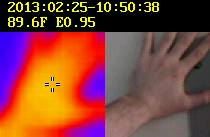
There is a bit of debate in the comments section of our Dewalt 12V thermal imaging camera preview post. Is the DCT416S1 resolution 15 x 15 pixels, or is the IR sensor actually larger?
From the above image, which is straight out of the Dewalt IR camera and enlarged but unenhanced, you can see that the resolution is definitely 15 x 15 px.
Advertisement
I have been passing the IR thermal camera around for testing, and thus far everyone likes it. For a $900 instrument, the image it produces is actually quite decent. Compared to more expensive thermal imagers double or almost triple the price, the limited resolving power does become more apparent.


The photo of the thermal camera’s LCD screen is not perfectly in focus, in order to blur the screen’s pixels together slightly. Otherwise the pixelation of the screen shows through and makes it look a lot less lifelike.
Buy Now(via Amazon)
Steven B
Why is the resolution so low? I don’t understand how thermal imagers work. Why aren’t they super simple? We have laser thermometers which take a temperature nearly instantly, I could make a 15×15 grid by measuring those numbers by hand and graphing it.
Why can’t you make a thermal image by scanning with a laser thermometer and graphing the result?
Stuart
What you have is probably an IR thermometer, not a laser thermometer. The laser is there for aiming purposes. The actual size of the measured area gets quite large the further away you are from whatever it is you’re measuring.
For example, Dewalt’s 12V IR thermometer has a sampling spot size of 3-inches when you’re 3-feet away.
So you *can* make a 15×15 grid using an IR thermometer, but you’re not going to get very usable data without moving to software that can visually plot all 225 data points with a fast refresh rate.
IR sensors are expensive and have to be precise with a large temperature sensitivity range.
$900 for 15 x 15 is quite good. Milwaukee’s thermal imager has 160 x 120 px resolution, but comes with a $2500 price tag.
FLIR’s i3, which has 60 x 60 resolution, is priced at $1100. The i5 and i7 have higher resolutions and higher price tags.
Anyways, yes you can make a thermal image by scanning with a super precise IR thermometer, but you’re going to get poorer results. I did see a few examples of homebrew thermal cameras before, but their results don’t at all rival what you can do with a true thermal camera such as this one.
Kris Lee
Thank you for the sample image! (please see also my reply under previous post).
I can see that this DeWalt device works fairly well for the small features (I can imagine using it for looking cold spots inside the house – much easier than with a IR thermometer that can only read temperature of one spot).
Would it possible for you to take the image of something bigger like a house?
What would be even more interesting is a side by side comparision between DeWalt DCT416S1 and Flir i3. Would it possible for you to do this?